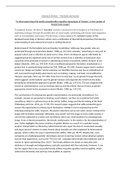Literature Review – The Body and Society
To what extent does the media sensationalise negative stereotypes of ‘beauty’, in the context of
female body image?
Throughout history, the idea of ‘beautiful’ women is profound in the emergence of Feminism as a
marketing strategy, through the proliferation of social media, advertising and female style magazines
such as Cosmopolitan and Grazia. This literature review explores the turbulent nature of the
idealised female body in Western culture and a combination of theoretical perspectives that develop
understanding of such phenomena found in existing literature.
Butlers book of ‘Performativity Acts and Gender Constitution’ addresses how gender roles are
performed through social practices (Butler, 1988, pp. 519-531), whereby, ‘advertising is a key part of
popular culture and a reflection of social norms’ (Clay, 2017). De Beauvoir agrees with Butler by
suggesting that the expected social role of women evolves from a collection of behaviours that
transcend in the portrayal of women in advertising as either a housewife, selfless nurturer or sex
object (Stoetzler, 2005, pp. 343-354). From a neoliberal perspective the body is emphasised as a
project that is constantly being worked on (Gill, 2008, pp. 432-445). Howson argues that in modern
society we ‘design our bodies’ and by extension our identities because one has an embodiment of
self, exercised through bodily adornments such as clothing, makeup, and body commodification
(Howson and Inglis, 2001, pp. 297-300). From this it is clear that ‘we do gender through the body’
which suggests ‘performativity’ governs gender division and separates the mind from the body,
providing an existentialist approach to gender (Butler, 1988, pp. 519-531). The acts assigned with
women in advertisements, such as wearing make-up and the clothes that are chosen as gender
appropriate should not be assumed as natural (Butler, 1988, pp. 519-531).
The constructions of contemporary gender representation are profoundly contradictory. For
example, women are presented as desiring, social subjects, yet they are scrutinised by hostile
surveillance, which is a primary focus in the article ‘Selfies, Image and the Re-making of the Body’
(Tiidenburg and Cruz, 2015, pp. 77-92). The research paper suggests that selfie production gives
women the opportunity to actively invent themselves. Initially it can be empowering for the
individual posting the selfie, however, the posters intentions can be lost when viewers interpret the
image with normative meanings. Ultimately, once power over the image is lost to wider society, it
can become subjected to scrutiny and surveillance which can create problems surrounding body
image. From a Marxist perspective, the female ‘performance’ in the media is for the subordination of
men. Butler highlights the power relations of gender division as a result of a capitalist society.
Another interpretation is offered by radical feminists who reject the idea of constructed sexuality
and argue women’s desires to make choices about sexuality are often neglected by heterosexual
agenda, which is often the case in advertisements (Willis, 1984, pp. 98-99). Despite this, more
companies are challenging gender stereotypes and aim to portray women whose physical capital is
not just their appearance, such as the ‘This Girl Can’ campaign which breaks the traditional rules of
women in sports advertising (Clay, 2017). The female athletes are shown as masculine with
attributes of strength and independence, typically associated with the male body. However, it can
also be argued that to be a successful female athlete masculine qualities must be applied, which
undermines femininity and portrays male qualities as superior.
, relations are profoundly
contradictory. On the one
hand, young women are
hailed through a discourse of
‘‘can-do’’ girl power, yet on
the other their bodies
are powerfully re-inscribed
as sexual objects; on the one
hand women are
presented as active, desiring
social subjects, yet on the
other they are subject to a
level of scrutiny and hostile
surveillance that has no
historical precedent. The
patterned nature of the
contradictions is what
constitutes the sensibility, a





